
Carina is a constellation in the southern sky. Its name is Latin for the keel of a ship, and it was the southern foundation of the larger constellation of Argo Navis until it was divided into three pieces, the other two being Puppis, and Vela.

Fornax is a constellation in the southern celestial hemisphere, partly ringed by the celestial river Eridanus. Its name is Latin for furnace. It was named by French astronomer Nicolas Louis de Lacaille in 1756. Fornax is one of the 88 modern constellations.
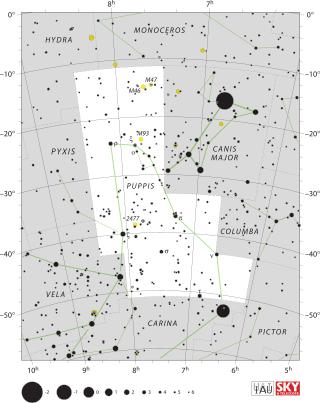
Puppis ("stern") is a constellation in the southern sky. It was originally part of the traditional constellation of Argo Navis, which was divided into three parts, the other two being Carina, and Vela. Puppis is the largest of the three constellations in square degrees. It is one of the 88 modern constellations recognized by the International Astronomical Union.

Messier 4 or M4 is a globular cluster in the constellation of Scorpius. It was discovered by Philippe Loys de Chéseaux in 1745 and catalogued by Charles Messier in 1764. It was the first globular cluster in which individual stars were resolved.
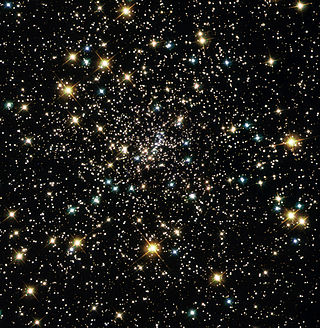
NGC 6397 is a globular cluster in the constellation Ara that was discovered by French astronomer Nicolas-Louis de Lacaille in 1752. It is located about 7,800 light-years from Earth, making it one of the two nearest globular clusters to Earth. The cluster contains around 400,000 stars, and can be seen with the naked eye under good observing conditions.

The Jewel Box is an open cluster in the constellation Crux, originally discovered by Nicolas Louis de Lacaille in 1751–1752. This cluster was later named the Jewel Box by John Herschel when he described its telescopic appearance as "... a superb piece of fancy jewellery". It is easily visible to the naked eye as a hazy star some 1.0° southeast of the first-magnitude star Mimosa. This hazy star was given the Bayer star designation "Kappa Crucis", from which the cluster takes one of its common names. The modern designation Kappa Crucis has been assigned to one of the stars in the base of the A-shaped asterism of the cluster.

Messier 7 or M7, also designated NGC 6475 and sometimes known as the Ptolemy Cluster, is an open cluster of stars in the constellation of Scorpius. The cluster is easily detectable with the naked eye, close to the "stinger" of Scorpius. With a declination of −34.8°, it is the southernmost Messier object.
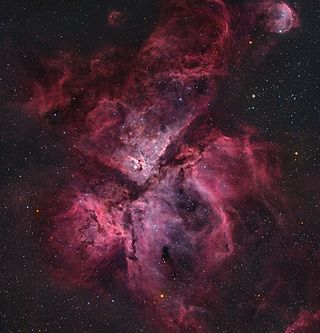
The Carina Nebula or Eta Carinae Nebula is a large, complex area of bright and dark nebulosity in the constellation Carina, located in the Carina–Sagittarius Arm of the Milky Way galaxy. The nebula is approximately 8,500 light-years (2,600 pc) from Earth.
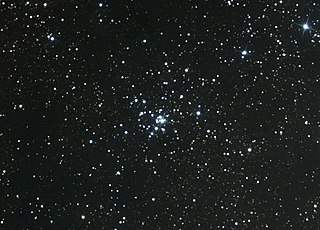
Messier 21 or M21, also designated NGC 6531 or Webb's Cross, is an open cluster of stars located to the north-east of Sagittarius in the night sky, close to the Messier objects M20 to M25. It was discovered and catalogued by Charles Messier on June 5, 1764. This cluster is relatively young and tightly packed. A few blue giant stars have been identified in the cluster, but Messier 21 is composed mainly of small dim stars. With a magnitude of 6.5, M21 is not visible to the naked eye; however, with the smallest binoculars it can be easily spotted on a dark night. The cluster is positioned near the Trifid nebula, but is not associated with that nebulosity. It forms part of the Sagittarius OB1 association.
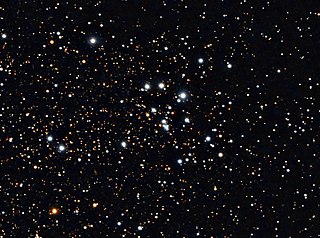
Messier 18 or M18, also designated NGC 6613 and sometimes known as the Black Swan Cluster, is an open cluster of stars in the constellation Sagittarius. It was discovered by Charles Messier in 1764 and included in his list of comet-like objects. From the perspective of Earth, M18 is situated between the Omega Nebula (M17) and the Small Sagittarius Star Cloud (M24).

Messier 93 or M93, also known as NGC 2447 or the Critter Cluster, is an open cluster in the modestly southern constellation Puppis, the imagined poop deck of the legendary Argo.
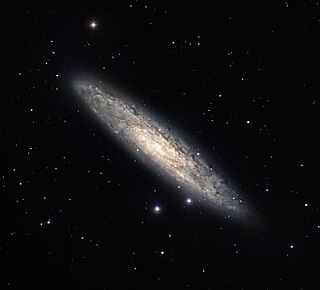
The Sculptor Galaxy is an intermediate spiral galaxy in the constellation Sculptor. The Sculptor Galaxy is a starburst galaxy, which means that it is currently undergoing a period of intense star formation.

NGC 2362, also known as Caldwell 64, is an open cluster of stars in the southern constellation of Canis Major. It was discovered by the Italian court astronomer Giovanni Batista Hodierna, who published his finding in 1654. William Herschel called it a "beautiful cluster", while William Henry Smyth said it "has a beautiful appearance, the bright white star being surrounded by a rich gathering of minute companions, in a slightly elongated form, and nearly vertical position". In the past it has also been listed as a nebula, but in 1930 Robert J. Trumpler found no evidence of nebulosity. The brightest member star system is Tau Canis Majoris, and therefore it is sometimes called the Tau Canis Majoris Cluster.
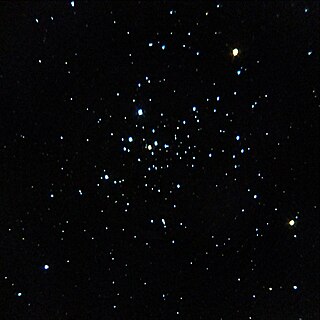
NGC 2516 is an open star cluster in the southern sky in the constellation Carina discovered by Abbe Lacaille in 1751-1752. It is also called Southern Beehive or the Sprinter.

NGC 6231 is an open cluster in the southern sky located half a degrees north of Zeta Scorpii. NGC 6231 is part of a swath of young, bluish stars in the constellation Scorpius known as the Scorpius OB1 association. The star Zeta1 is a member of this association, while its brighter apparent partner, Zeta2, is only 150 ly from Earth and so is not a member.

The Caldwell catalogue is an astronomical catalogue of 109 star clusters, nebulae, and galaxies for observation by amateur astronomers. The list was compiled by Patrick Moore as a complement to the Messier catalogue.

NGC 2867 is an elliptical Type II planetary nebula in the southern constellation of Carina, just over a degree to the NNW of the star Iota Carinae. It was discovered by John Herschel on April 1, 1834. Herschel initially thought he might have found a new planet, but on the following night he checked again and discovered it had not moved. The nebula is located at a distance of 7,270 light-years from the Sun.

NGC 265 is an open cluster of stars in the southern constellation of Tucana. It is located in the Small Magellanic Cloud, a nearby dwarf galaxy. The cluster was discovered by English astronomer John Herschel on April 11, 1834. J. L. E. Dreyer described it as, "faint, pretty small, round", and added it as the 265th entry in his New General Catalogue.

NGC 3242 is a planetary nebula located in the constellation Hydra.

NGC 2244 is an open cluster in the Rosette Nebula, which is located in the constellation Monoceros. This cluster has several O-type stars, super hot stars that generate large amounts of radiation and stellar wind.






















